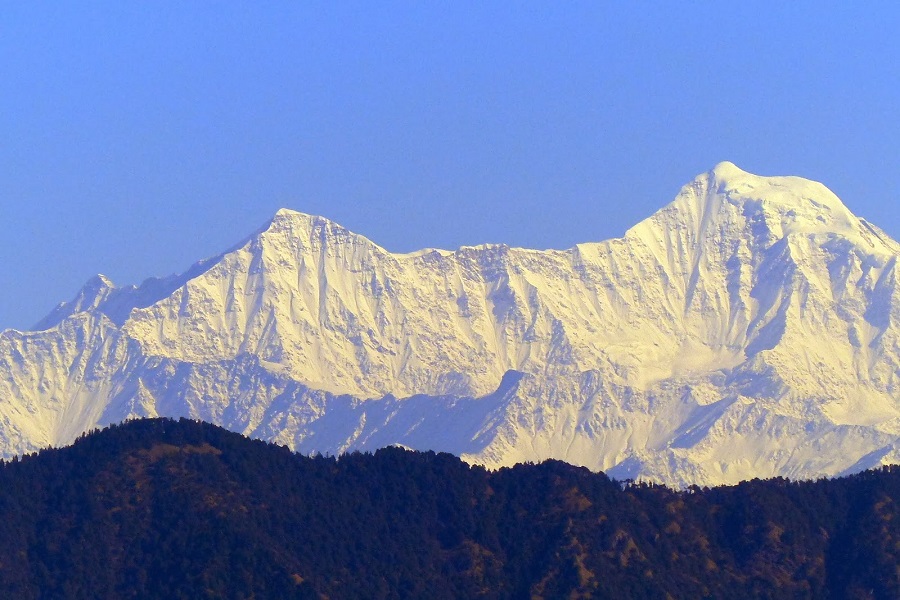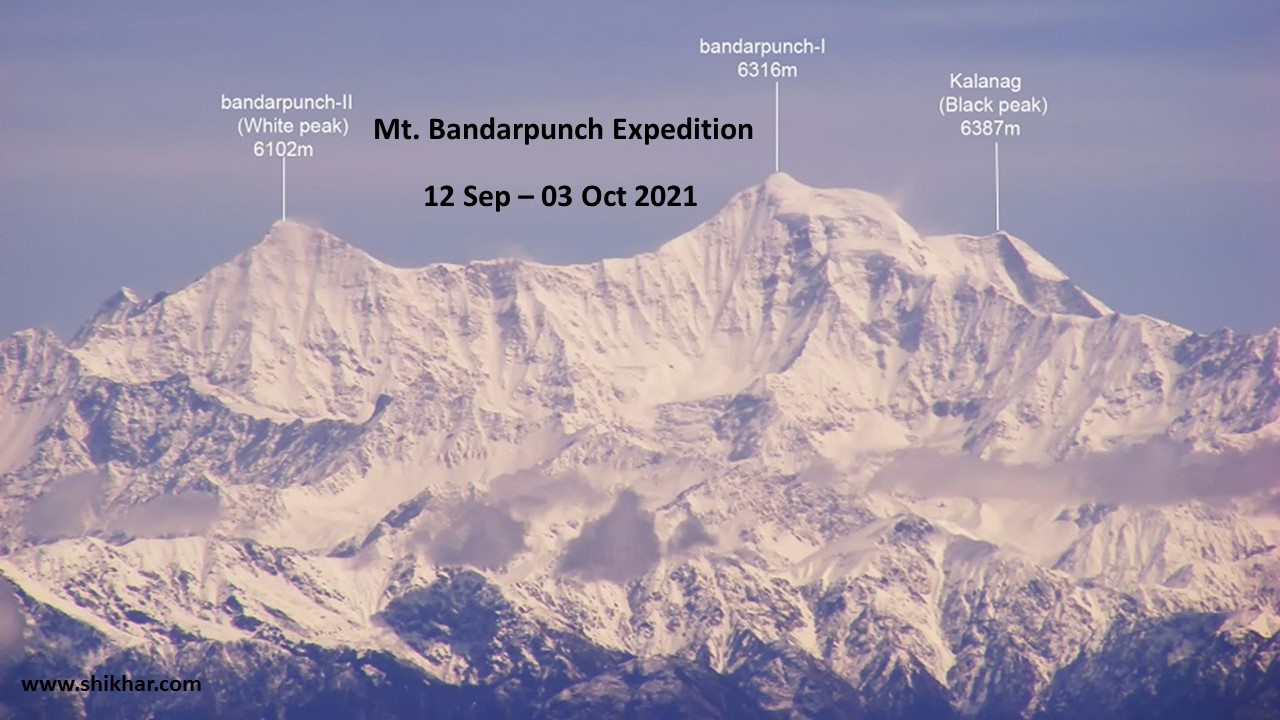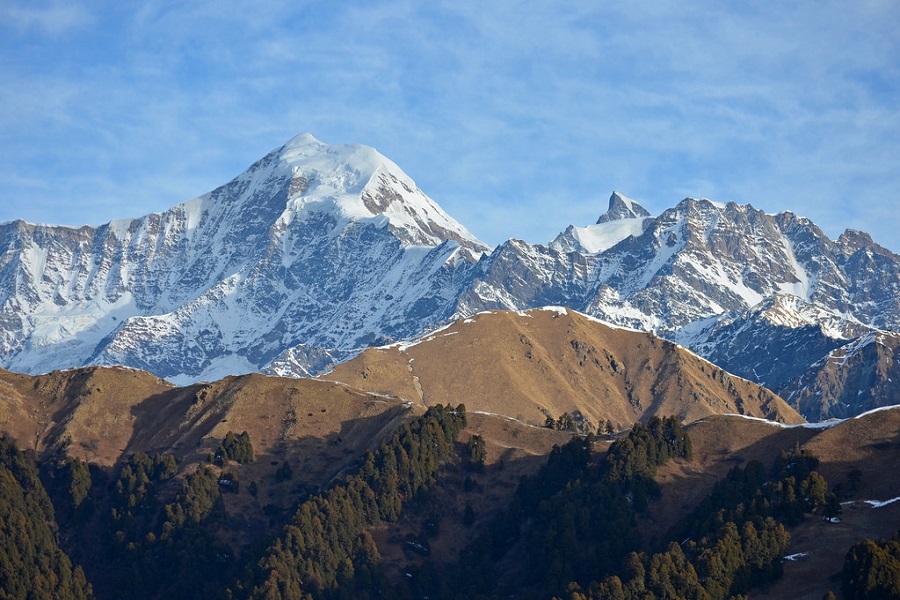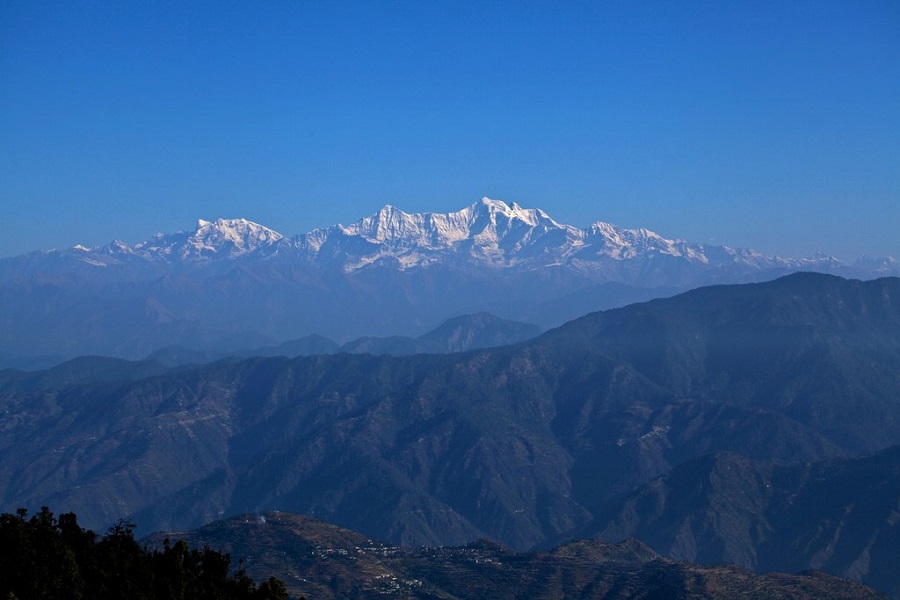Bandarpunch Peak, Uttarakhand
Mount Bandarpunch is a mountain peak located in the Indian state of Uttarakhand, in the Garhwal region of the Western Himalayas. It is part of the Bandarpunch massif and has an elevation of 6316 meters (20,700 feet).
Mount Bandarpunch is a popular destination for trekkers and mountaineers, offering a challenging and rewarding trekking experience. The trek to the summit of Mount Bandarpunch passes through dense forests, alpine meadows, and glaciers, providing a glimpse of the diverse flora and fauna of the region.
The Expedition to Mount Bandarpunch starts from the village of Taluka, located in the Uttarkashi district. The trek route passes through the Hargaon, Seema, and Ruinsara Tal base camp before reaching the summit. The trek to the summit can be completed in 7-8 days and is considered a moderate to challenging trek.

Climbing History
Mount Bandarpunch is a relatively less explored and less climbed mountain peak in the Indian Himalayas. The first successful ascent of the peak was made in 1950 by a team of British climbers. Since then, it has become a popular trekking and climbing destination, attracting adventurers and mountaineers from around the world.
However, due to its remote location and challenging terrain, climbing Mount Bandarpunch requires a high level of physical fitness and technical expertise. The peak is typically climbed during the summer months of June to September, when the weather is stable and the snow has melted on the higher slopes.
Overall, the history of climbing on Mount Bandarpunch is relatively short, but the peak continues to be a challenging and rewarding destination for those who are passionate about adventure and mountain climbing.
Best Time to Visit
The best time to visit Mount Bandarpunch depends on your purpose of visit. If you are planning to trek or climb the peak, the best time is typically from June to September, when the weather is stable and the snow has melted on the higher slopes. During these months, the days are warm and the nights are cool, making it ideal for outdoor activities.
If you are just visiting the area for sightseeing or exploring the local culture, the best time would be from April to June or from September to November, when the weather is mild and pleasant, and the monsoon season has ended.
It is important to note that the weather in the mountains can be unpredictable and can change quickly, so it is always advisable to be prepared for all conditions, no matter what time of year you visit.

Weather
The weather at Mount Bandarpunch can vary greatly depending on the time of year and altitude. The peak is located in the western part of the Great Himalayan Range, and is subject to harsh, cold weather conditions for much of the year.
In the summer months of June to September, the weather is generally warm and stable, with temperatures ranging from 15°C to 25°C during the day and 5°C to 10°C at night. However, it is always advisable to carry warm clothing and rain gear, as the weather can change quickly and unexpectedly.
In the winter months of December to February, the weather is cold and snowy, with temperatures often dropping below freezing. Snow can make trekking and climbing difficult, and can also make the trails and roads in the area impassable.
Overall, it is important to be prepared for all weather conditions when visiting Mount Bandarpunch, and to plan your trip carefully based on the time of year and the current weather conditions.

How to Reach
The following are the ways to reach Bandarpunch:
By Air: The nearest airport is Jolly Grant Airport in Dehradun, which is approximately 200 km from Bandarpunch. From the airport, you can take a taxi or a bus to reach the trekking starting point.
By Train: The nearest railway station is in Dehradun, which is well connected to major cities in India. From the railway station, you can take a taxi or a bus to reach the trekking starting point.
By Road: Bandarpunch is well connected by road and can be reached by car or bus from major cities such as Dehradun and Uttarkashi. The trek starting point is typically accessed via a rough mountain road, which may be difficult to navigate during the rainy season.
Route Map
The trek to Mount Bandarpunch typically starts from the town of Uttarkashi, which is located in the Indian state of Uttarakhand. From Uttarkashi, the route to Bandarpunch follows the following steps:
Uttarkashi to Sankri: The first step is to reach the village of Sankri, which is located about 200 km from Uttarkashi. Sankri is the last roadhead and the starting point for the trek to Bandarpunch.
Sankri to Taluka: From Sankri, the next step is to reach the village of Taluka, which is located about 6 km away. The trek from Sankri to Taluka is relatively easy and takes about 2-3 hours.
Taluka to Seema: From Taluka, the next step is to reach the village of Seema, which is located about 5 km away. The trek from Taluka to Seema takes about 4-5 hours and is slightly more challenging.
Seema to Bandarpunch Base Camp: From Seema, the next step is to reach the base camp of Bandarpunch, which is located about 4 km away. The trek from Seema to the base camp takes about 4-5 hours and is the most challenging part of the trek.
Base Camp to Summit: From the base camp, the final ascent to the summit of Bandarpunch can be made. The ascent to the summit takes about 4-5 hours and is a steep climb on snow and ice.
Things to Carry
When climb to the summit of Mount Bandarpunch, it is important to be well prepared and to carry the following essential items:
Clothing: Warm and waterproof clothing is essential, as the weather in the mountains can be unpredictable and can change quickly. A good quality down jacket, warm hat, gloves, and thick socks are all essential.
Footwear: Good quality, waterproof trekking boots are essential, as the trail can be slippery and wet. Gaiters and crampons may also be necessary if there is snow and ice on the trail.
Backpack: A good quality, waterproof backpack is essential, as it will protect your belongings from the rain and snow. The backpack should be big enough to carry all of your essentials, including food, water, and extra clothing.
Headlamp: A good quality, waterproof headlamp is essential, as you may be trekking in the dark, especially during the winter months.
First Aid Kit: A well-stocked first aid kit is essential, as the trail can be treacherous and injuries are always a risk. The first aid kit should include items such as pain relievers, bandages, antiseptic cream, and a blister kit.
Food and Water: Adequate food and water are essential, as the trail can be physically demanding and you will need to stay hydrated and well-nourished. High-energy snacks, such as energy bars and dried fruits, are a good choice.
Sunscreen: Sunscreen is essential, as the sun can be intense at high altitudes.
Navigation Tools: A map and compass, or a GPS device, are essential for navigation and to ensure that you can find your way back to the trailhead.

Food Guide
It is important to carry enough food to keep you well-nourished and energized during the physically demanding journey. Here are some guidelines for food and nutrition on the trek:
High-Energy Snacks: Snacks such as energy bars, dried fruits, and nuts are a good choice, as they are easy to carry and provide a quick energy boost when needed.
Meal Supplements: Meal supplements, such as instant noodles, soups, and dehydrated meals, are a good option for lunch and dinner. These meals are quick and easy to prepare and provide a balanced combination of carbohydrates, proteins, and fats.
Hydration: Staying hydrated is essential, especially at high altitudes where dehydration can occur more quickly. It is important to carry enough water for the entire trek and to drink regularly, even if you are not feeling thirsty.
Electrolyte Drinks: Electrolyte drinks can help to replace the salt and minerals that are lost through sweating and can help to prevent dehydration.
Caffeine: Caffeine can be a helpful stimulant, especially during the early stages of the trek when you may be feeling tired. However, it is important to avoid consuming too much caffeine, as it can also lead to dehydration.
It is important to note that these are just general guidelines and that the exact food and drinks you need to carry will depend on the conditions you will face on your trek and your personal preferences. It is always a good idea to check the current weather conditions and trail conditions before setting out on your trek to ensure that you are prepared for the conditions you will face.
Places to Visit during Mt. Bandarpunch Expedition
There are several places to visit during a Mount Bandarpunch expedition. Some of the highlights include:
Har ki Dun Valley: Har ki Dun is a picturesque valley located near Mount Bandarpunch. The valley is surrounded by stunning peaks and is a popular destination for trekkers and nature lovers.
Sankri Village: Sankri is a small village located near Mount Bandarpunch. It is the starting point for many trekking expeditions in the region and is known for its beautiful, traditional architecture and warm hospitality.
Osala Village: Osala is a small village located near Sankri. It is known for its traditional architecture and stunning views of the surrounding mountains.
Debshu Bugyal: Debshu Bugyal is a beautiful high-altitude meadow located near Mount Bandarpunch. It is a popular destination for trekkers and nature lovers, and offers stunning views of the surrounding peaks.
Ruinsara Tal: Ruinsara Tal is a beautiful high-altitude lake located near Mount Bandarpunch. It is surrounded by stunning peaks and is a popular destination for trekkers and nature lovers.
These are just a few of the many places to visit during a Mount Bandarpunch expedition. The exact places you can visit will depend on the route you take and the conditions you face during your trek.
Travel Tips
Here are some tips to help you plan and prepare for a successful climb of Mount Bandarpunch:
Research the trek: Research the trek thoroughly before setting out, and make sure you are aware of the trail conditions, weather conditions, and any other important information.
Get in shape: Make sure you are physically fit and have the necessary strength, endurance, and flexibility to complete the trek. You can prepare for the trek by doing regular exercise, such as hiking, running, or cycling, and by building up your stamina and strength.
Pack wisely: Pack wisely, making sure you have the necessary clothing, gear, and equipment to cope with the changing weather conditions and other conditions you may encounter during the trek.
Stay hydrated: Stay hydrated at all times during the trek, and make sure you carry enough water to last you throughout the entire journey.
Take rest days: Make sure you take adequate rest days during the trek to allow your body to recover and prevent exhaustion.
Hire a guide: Consider hiring a guide, especially if you are a first-time trekker or if you are not familiar with the trail conditions. A guide can provide important information, help you navigate the trail, and offer support and assistance during the trek.
Respect the environment: Respect the environment and be mindful of the impact you have on the environment and local communities. Take care not to litter, and follow the “leave no trace” principles when trekking.
By following these tips and taking the necessary precautions, you can have a safe and successful climb of Mount Bandarpunch.
FAQ
Here are some frequently asked questions about Mount Bandarpunch:
1- What is Mount Bandarpunch?
Mount Bandarpunch is a mountain peak located in the Indian state of Uttarakhand. It is part of the Garhwal Himalayan range and is a popular destination for trekkers and mountaineers.
2- Where is Mount Bandarpunch located?
Mount Bandarpunch is located in the Uttarkashi district of Uttarakhand, India.
3- What is the best time to visit Mount Bandarpunch?
The best time to visit Mount Bandarpunch is during the months of May to June and September to November, when the weather is clear and the trail conditions are favorable.
4- How difficult is the climb to Mount Bandarpunch?
The climb to Mount Bandarpunch is considered to be a moderate to difficult trek, and requires a good level of physical fitness and trekking experience.
5- How long does it take to climb Mount Bandarpunch?
The trek to Mount Bandarpunch typically takes about 7-8 days to complete, depending on the trail conditions and the pace of the trekker.
6- What is the highest elevation of Mount Bandarpunch?
The highest elevation of Mount Bandarpunch is 6,316 meters (20,720 feet).
7- What is the route to Mount Bandarpunch?
The most common route to Mount Bandarpunch is from the village of Sankri, located in the Uttarkashi district of Uttarakhand. From Sankri, the trail passes through the villages of Osala and Seema, and culminates at the summit of Mount Bandarpunch.
8- What is the weather like on Mount Bandarpunch?
The weather on Mount Bandarpunch can be highly unpredictable and can change rapidly. During the summer months, the weather is generally warm and sunny, while during the winter months, temperatures can drop well below freezing and the trail can be covered in snow and ice.
9- What should I carry on the climb to Mount Bandarpunch?
When climbing Mount Bandarpunch, it is important to carry adequate clothing, gear, and equipment to cope with the changing weather conditions and other conditions you may encounter during the trek. Some of the essential items you should carry include waterproof clothing, a warm sleeping bag, a good quality tent, a first-aid kit, and adequate food and water supplies.
- Suggested Packages: Mountaineering Expeditions In The Indian Himalayas